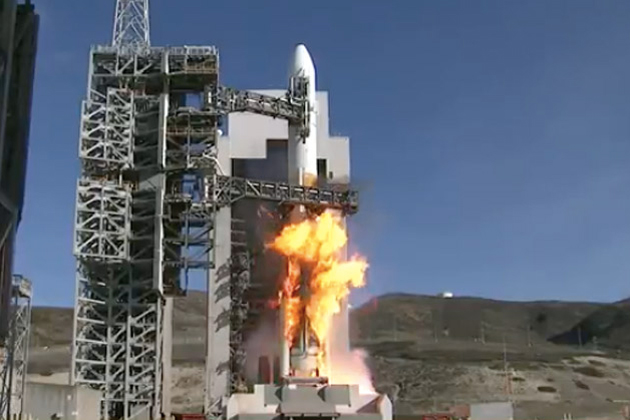United Launch Alliance (ULA) successfully completed its first flight of 2018 on Friday, January 12, two days after high ground winds forced the scrubbing of the initial launch attempt and one day after a ground system valve forced a second scrub.
A ULA Delta IV Medium+(5,2) carrying the classified NROL-47 payload lifted off from Vandenberg Air Force Base’s Space Launch Complex 6 at 2:11 p.m. PST (5:11 p.m. EST). The mission was ULA’s 27th flight for the National Reconnaissance Office (NRO) and the 36th flight of the Delta IV rocket, which first flew in 2002. This flight marked the first of 2018 for ULA.
“As the nation’s most trustworthy launch provider, today’s launch exemplifies ULA’s ongoing commitment to 100 percent mission success,” said Will Crawford, ULA’s NRO program manager via a release. “My sincere thanks to the entire ULA team and our mission partners at the NRO and U.S. Air Force who made this, our 27th NRO launch, possible.”
The NRO is the U.S, Government agency in charge of designing, building, launching and maintaining America’s fleet of intelligence satellites. The agency was formed in 1961 and was declassified to the public in 1992. NROL-47 is NRO’s 50th launch since 1996.
Due to the mission’s classified nature, little is known about the NROL-47 payload, but it is believed to be radar reconnaissance satellite, operating from a retrograde orbit inclined 123 degrees. NROL-47 will join the Future Imagery Architecture (FIA) satellite constellation, which flies under the code name Topaz.
The NROL-47 mission marked the final flight of the Medium+ (5,2) variant of the Delta IV rocket, which has two Orbital ATK GEM-60 solid rocket motors attached the the exterior of the rocket’s Common Booster Core (CBC) and a 5-meter diameter payload fairing. The main engine of the Delta IV is the RS-68A, manufactured by Aerojet Rocketdyne. The rocket’s second stage is propelled by an RL-10 engine.
Thursday morning’s weather report from the 30th Space Wing showed an 80 percent chance of favorable conditions, a considerable improvement over the previous day’s 40 percent. However, this was not the only variable thrown at the launch team with an issue with a ground system valve forcing mission managers to call a scrub for the Thursday, Jan. 11 launch attempt(s) as well.
United Launch Alliance’s CEO and President, Tory Bruno expressed the excitement of seeing the final planned launch of a Delta IV Medium+ (5,2) soar through California’s skies when he tweeted: “Delta is ripping the sky at incredible speed.”
The Delta IV Medium+ (5,2) rocket is part of a family of launch vehicles that are described as follows by the Colorado-based launch service provider:
The Delta IV family of launch vehicles combines design simplicity, manufacturing efficiency, and streamlined mission and vehicle integration to meet customer requirements to launch high-priority U.S. Air Force (USAF), National Reconnaissance Office (NRO), NASA, and commercial payloads to orbit.
With operational launch pads on both coasts—Space Launch Complex-37 at Cape Canaveral Air Force Station, Fla., and Space Launch Complex-6 at Vandenberg Air Force Base, Calif.—every Delta IV configuration is available to service the requirements of current and future satellite programs.
The Delta IV launch system is available in five configurations: the Delta IV Medium (Delta IV M), three variants of the Delta IV Medium-Plus (Delta IV M+), and the Delta IV Heavy (Delta IV H). Each configuration is comprised of a common booster core (CBC), a cryogenic upper stage and either a 4-m-diameter or 5-m-diameter payload fairing (PLF).
There are three variants of Delta IV M+ configuration. The Delta IV M+(4,2) uses two strap-on solid rocket motors (SRMs – GEM-60 boosters provided by Orbital ATK) to augment the first-stage CBC and a 4-m diameter PLF. The Delta IV M+(5,2) and Delta IV M+(5,4) have two and four SRMs, respectively, and 5-m-diameter PLF.
“Another successful Delta IV launch is testament to our highly engineered composite structures, unwavering commitment and exceptional teamwork to ensure dependable access to space and affordable innovation in delivering this critical asset for our nation’s security,” said Steve Earl, Vice President and General Manager of Orbital ATK’s Aerospace Structures Division via a release.
The Graphite Epoxy Motors (GEM 60) used on the Delta IV family of rockets measure some 53-feet (16 meters) in length. They burned for about 90 seconds and provided more than 560,000 pounds of thrust. These have been used on the Delta IV since its initial flight in 2002.
The GEM 60s provided additional thrust to the lone Aerojet Rocketdyne RS-68A engine located in the Delta IV’s first stage. The RS-68A engine provided an estimated 702,000 pounds of thrust during the initial phase of the flight. After staging, an Aerojet Rocketdyne RL10B-2 granted some 24,750 pounds of thrust, sending the Delta IV’s upper stage to orbit.
“The successful launch of a payload in support of our national security and that of allied forces demands the best propulsion systems available,” said Aerojet Rocketdyne CEO and President Eileen Drake in a statement issued by the company. “Aerojet Rocketdyne employees across the country work hard to ensure 100 percent mission success, and our role in yet another launch for the National Reconnaissance Office demonstrates the trust and confidence in our propulsion.”
ULA’s next planned flight is the launch of an Atlas V 411 rocket with the Space Based Infrared System (SBIRS) GEO Flight 4 spacecraft for the U.S. Air Force. At present, that mission is scheduled to get underway on Thursday, Jan. 18 from Cape Canaveral Air Force Station’s Space Launch Complex 41 located in Floridae launch is scheduled for Jan. 18 from Space Launch Complex-41 at Cape Canaveral Air Force Station, Fla.















